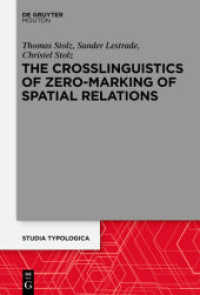- ホーム
- > 洋書
- > ドイツ書
- > Mathematics, Sciences & Technology
- > Chemistry
Full Description
Comprehensive resource on the fundamentals, recent research developments, and applications of triboelectric nanogenerators (TENGs)
Triboelectric Nanogenerators delivers a comprehensive overview of a lightweight, low cost, and high-efficiency sustainable mechanical energy harvesting technique that draws from the ambient environment and has high output and extremely flexible structural designs.
The book starts with an introduction on triboelectric nanogenerator technology, then continues to discuss the latest fundamental studies about TENGs, including models of triboelectric effect, the discharge effect, and standardized evaluation. The next part explains new output performance promotion of TENGs for power generation applications, including output promotion through multiple methods, as well as power management and effective energy storage. The last part explores new concepts inspired by the field of TENGs, including applications in sensing, actuation, data science, artificial intelligence (AI), the Internet of Things (IoT), and smart cities.
Written by a team of highly qualified academics with significant research experience in the field, Triboelectric Nanogenerators includes information on:
Triboelectric charge generation and discharge, highlighting how electrostatic energy is often wasted
Energy potential of TENGs in comparison to other sources such as lithium-ion batteries and other types of batteries
Methods to promote and configure output performance, such as through gas environments, liquid-solid interfaces, and electromechanical structures
High-voltage output from TENGs and its potential for new applications in areas such as breakdown charge triggering, electrospraying, field emissions, and others
Triboelectric Nanogenerators is an essential reference for scientists, engineers, students, and professionals in related fields seeking to understand this exciting energy harvesting technique and gain all of the knowledge needed to help further progress in the field.
Contents
Preface xi
Introduction of Triboelectric Nanogenerator 1
I.1 What is a Triboelectric Nanogenerator (TENG)? 1
I.2 First-Principle Theoretical Model 1
I.3 Equivalent Circuit Models and Basic Operation Modes 2
I.4 Energy Conversion and Electromechanical Coupling Models 19
I.5 Summary 21
References 21
1 Models of Triboelectric Effect 25
1.1 Introduction 25
1.2 Thermionic Emission Method 26
1.3 Material-Dependent Charge Transfer Mechanism and Model 29
1.4 Liquid-Solid Contact Electrification Mechanism 32
1.5 Environmental and Material Effects on Charge Transfer 34
1.6 Potential Applications 37
1.7 Summary 38
References 38
2 Discharge Effects in TENG 45
2.1 Introduction 45
2.2 Theoretical Studies of Breakdown Discharge in Contact-Separation-Based TENGs 49
2.3 Experimental Verification and Quantitative Measurements 49
2.4 Photon Generation 56
2.5 Potential Applications 58
2.6 Summary 58
References 59
3 Figure-of-Merit of Triboelectric Nanogenerator 61
3.1 Introduction 61
3.2 Effective Maximized Energy Output 62
3.3 Figure-of-Merit 67
3.4 Output Energy Density 70
3.5 Environmental and Techno-Economic Analysis 72
3.6 Potential Applications 74
3.7 Summary 74
References 74
4 Output Promotion by Environment 79
4.1 High Vacuum Environment 79
4.2 High Atmospheric Pressure and High-Breakdown-Limit Gas Environments 80
4.3 Interfacial Liquid Lubrication 83
4.4 Humidity 86
4.5 Summary 89
References 89
5 DC-TENG: A New Paradigm 93
5.1 Introduction 93
5.2 Basic Principle 94
5.3 Physical Model 95
5.4 Optimization Methods for DC-TENG 96
5.5 DC-TENG for Energy Harvesting 103
5.6 DC-TENG for Self-Powered Sensing 105
5.7 Hybrid of AC-TENG and DC-TENG 106
5.8 Summary 109
References 110
6 Promotion of Contact Electrification at Liquid-Solid Interface 113
6.1 Introduction 113
References 120
7 Output Promotion of Triboelectric Nanogenerator by Electromechanical Structures 125
7.1 Introduction 125
7.2 Charge Excitation Mechanism 128
7.3 Other Promotion Strategies 135
7.4 Summary 140
References 141
8 Power Management and Effective Energy Storage 145
8.1 Introduction 145
8.2 Theoretical Basis of Energy Management for TENG 147
8.3 Mechanical Switched Converter 150
8.4 Electronic Switch Converter 159
8.5 Transformer Converter 165
8.6 Conclusion and Perspective 167
References 170
9 Tribotronics 175
9.1 Introduction 175
9.2 Tribo-Potential 176
9.3 Triboelectricity Modulate Field Effect 177
9.4 Tribotronic Transistor 181
9.5 Tribotronic Functional Devices 186
9.6 Conclusion 196
References 198
10 Tribophotonics 203
10.1 Introduction 203
10.2 Tribophotonics: Concept, Origin, Characteristics, and Potential Applications 205
10.3 Tribo-Induced EM-Wave Generation (TIEG) 207
10.4 Tribo-Induced Light Propagation Tuning (TILPT) 215
10.5 Triboelectrification-Induced Electroluminescence (TIEL) 220
10.6 Tribo-Assisted Spectrometry (TAS) 225
10.7 Potential Applications and Perspectives 227
10.8 Challenges and Summary 228
References 229
11 TENG-Based Wearable Biomechanical Sensors and Human-Machine Interface 237
11.1 Introduction 237
11.2 TENG-Based Biomedical Sensing 238
11.3 TENG-Based Human-Machine Interface 245
11.4 Summary 254
References 254
12 TENG as the High-Voltage Source 259
12.1 Introduction 259
12.2 Overview of Materials and Universal Methods for TENG's Performance Enhancement 261
12.3 Artificial Muscle Based on Dielectric Elastomer and TENG 268
12.4 Microactuators Based on Piezoelectric Ceramics and TENG 272
12.5 Materials Polarized by the High Voltage Output From TENG 273
12.6 Electrostatic Manipulator Driven by TENG 278
12.7 Electrostatic Adsorption and Air Cleaning Based on TENG 282
12.8 Electronic Excitation and Ion Generation Powered by TENG 287
12.9 Summary and Perspectives 294
References 296
Index 299








